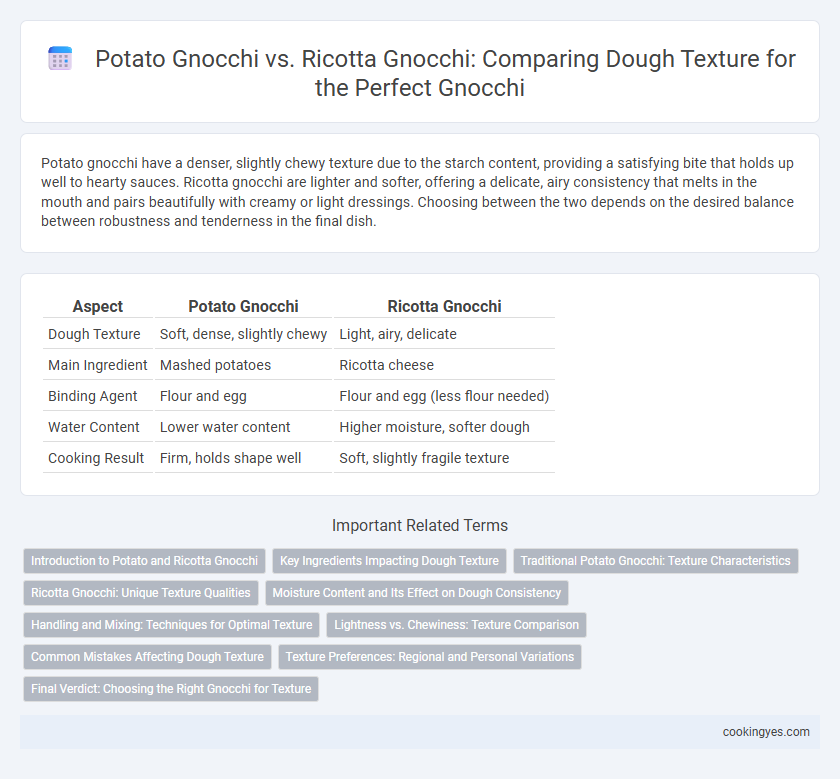Potato gnocchi have a denser, slightly chewy texture due to the starch content, providing a satisfying bite that holds up well to hearty sauces. Ricotta gnocchi are lighter and softer, offering a delicate, airy consistency that melts in the mouth and pairs beautifully with creamy or light dressings. Choosing between the two depends on the desired balance between robustness and tenderness in the final dish.
Table of Comparison
| Aspect | Potato Gnocchi | Ricotta Gnocchi |
|---|---|---|
| Dough Texture | Soft, dense, slightly chewy | Light, airy, delicate |
| Main Ingredient | Mashed potatoes | Ricotta cheese |
| Binding Agent | Flour and egg | Flour and egg (less flour needed) |
| Water Content | Lower water content | Higher moisture, softer dough |
| Cooking Result | Firm, holds shape well | Soft, slightly fragile texture |
Introduction to Potato and Ricotta Gnocchi
Potato gnocchi features a soft, pillowy dough texture achieved by combining cooked, mashed potatoes with flour, creating a tender yet slightly dense bite. Ricotta gnocchi utilizes creamy ricotta cheese mixed with flour and eggs, resulting in a lighter, fluffier consistency that melts in the mouth. Both varieties offer distinct dough textures, with potato gnocchi leaning toward a heartier chew and ricotta gnocchi providing an airy, delicate finish.
Key Ingredients Impacting Dough Texture
Potato gnocchi dough relies heavily on starchy potatoes combined with flour, creating a denser, chewier texture due to the potato's moisture and starch content. Ricotta gnocchi features a higher proportion of ricotta cheese, resulting in a lighter, creamier, and more delicate dough texture because of the cheese's moisture and fat content. The key ingredients--starch-rich potatoes versus moisture-rich ricotta--directly influence the elasticity and softness of the final gnocchi.
Traditional Potato Gnocchi: Texture Characteristics
Traditional potato gnocchi boast a soft, pillowy texture achieved by using starchy potatoes such as Russets, which provide the ideal moisture balance for tender dough. The dough's elasticity results from the proper ratio of potato to flour, creating delicate gnocchi that gently melt in the mouth. Unlike ricotta gnocchi, which have a lighter and creamier consistency, potato gnocchi maintain a firm yet airy bite, prized in authentic Italian cuisine.
Ricotta Gnocchi: Unique Texture Qualities
Ricotta gnocchi presents a delicate, tender texture compared to the denser, chewier consistency of traditional potato gnocchi. The high moisture content and creaminess of ricotta cheese result in a light, pillowy dough that melts in the mouth. This unique softness allows ricotta gnocchi to pair exceptionally well with light sauces, preserving its airy texture.
Moisture Content and Its Effect on Dough Consistency
Potato gnocchi dough typically contains higher moisture content due to the natural water in potatoes, resulting in a softer, more pliable texture that requires careful flour incorporation to avoid stickiness. Ricotta gnocchi dough, with its lower moisture content, offers a lighter and fluffier consistency, allowing for a tender bite with less risk of becoming dense or heavy. Managing moisture levels is crucial to achieving the desired dough consistency, where potato gnocchi demands a balance between hydration and flour, while ricotta gnocchi relies more on dairy moisture control.
Handling and Mixing: Techniques for Optimal Texture
Potato gnocchi dough requires gentle handling and minimal mixing to prevent excess gluten development, resulting in a light, airy texture. Ricotta gnocchi dough benefits from a slightly more rigorous mixing process to evenly incorporate cheese and flour, creating a tender yet cohesive bite. Both types demand careful flour measurement and delicate folding techniques to maintain softness without becoming dense.
Lightness vs. Chewiness: Texture Comparison
Potato gnocchi offers a soft, pillowy texture with a lightness that melts in the mouth, making it ideal for those who prefer tender, delicate dough. Ricotta gnocchi, in contrast, delivers a firmer, chewier texture due to the cheese's moisture and protein content, providing a more substantial bite. The choice between potato and ricotta gnocchi ultimately depends on whether a lighter or more resilient dough texture is desired.
Common Mistakes Affecting Dough Texture
Potato gnocchi often suffer from dense or gummy texture due to overworking the dough or using too much flour, while ricotta gnocchi commonly become too soft or fragile from excess moisture or insufficient binding agents. A key mistake in potato gnocchi preparation is boiling potatoes with high water content instead of baking them, which adds unwanted moisture and requires more flour, resulting in heavier dough. Ricotta gnocchi require careful draining and proper ratios of ricotta to flour and egg to maintain structure, as too much ricotta or liquid leads to dough that lacks elasticity and tears easily during cooking.
Texture Preferences: Regional and Personal Variations
Potato gnocchi offers a denser, chewier texture that is preferred in Northern Italian regions where heartier dishes are common, while ricotta gnocchi provides a lighter, fluffier consistency favored in Southern Italy and by those seeking a delicate mouthfeel. Texture preferences often vary due to regional culinary traditions, with potato gnocchi being ideal for robust sauces and ricotta gnocchi pairing well with simple, buttery dressings. Personal taste also plays a crucial role, as some enjoy the rustic firmness of potato gnocchi, whereas others prefer the smooth, airy quality of ricotta-based dough.
Final Verdict: Choosing the Right Gnocchi for Texture
Potato gnocchi offers a dense, chewy texture due to the starch content, making it ideal for those who prefer a heartier bite, while ricotta gnocchi delivers a lighter, creamier consistency with a tender dough that melts in the mouth. The final verdict depends on texture preference: potato gnocchi suits dishes requiring structure and bite retention, whereas ricotta gnocchi excels in delicate, soft presentations that prioritize smoothness. Selecting the right gnocchi dough type hinges on balancing starch density versus dairy freshness to achieve the desired mouthfeel and culinary application.
Potato gnocchi vs ricotta gnocchi for dough texture Infographic

 cookingyes.com
cookingyes.com